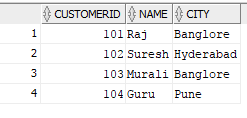PEGA
What is meant by PEGA?
PEGA is a business process management tool (BPM) that primary focuses on work flows or integrations capabilities.
PEGA PRPC (Pega Rules Process Commander)
PegaRules Process Commander is a software product by using which we build and developing the application and deploy.
BPM+BRE = PRPC
BPM(Business process management )
BPM is a methodology(set of instructions) to manage process and work flows in an organization.BPM which provides the ability to have end-to-end visibility and control over all parts of multi stepped transaction that spans multiple application and multiple people in one or more organization.
FOR EXAMPLE :
ATM CARD FLOW CHART
START
|
PUT The card in ATM machine
|
Enter the PIN number
| match
Verify the pin number ----------- Process the transaction
| un match |
END END
This is called End-To-End process.
In above flow chart one transaction perform different task. In a BPM implement unit of work represent it in the form of flow diagram.
Development representation of unit of work in the form of flow diagram by dividing into multiple steps at each and every step going to perform a task. This is what a multiple step transaction in BPM.
So many BPM tools are available in market like ORACLE BPM, IBM BPM, AL BPM, LOMBARD, TIBCO. When compare to the other BPM tool PEGA is most advanced tool.
We can develop an application in JAVA, .NET. C ........... etc. In java lot of coding is required. But we develop a application in PEGA no need to write a single line of code every thing is generated automatically. PEGA back end is developed by using java language.
BRE( Business Rule engine)
BRE is a software system that executes one or more business rules in a run time product environment.
Traditional Application Development VS BPM Application development
Traditional Application development:
They are three layers
User interface Layer
Logic Layer
Database Layer
When we develop application in programming language we design UI, define logic and access data keeping all these elements are separate for re-usability.
BPM Application development
We have to develop
UI Layer
Business Logic { All these three integrated to work flow or process in BPM}
Data Base
First implement a flow we need to add every thing into the work flow.When we access the BPM Application first it will trigger the flow. Work flow trigger the ' START ' position to 'END' position based on the decision.
In BPM tool we have
Enterprise Level Scalability
Standard based User Interface
Integration with other business platform
Process:
Process is unit of work that can be completed either by acceptances or rejection.
To developed an application we need an IDE. For example Applications developing by using JAVA we need ECLIPSE IDE for .NET we need MICROSOFT VISUAL STUDIO like that in a BPM we need a IDE to develop application called BPM SUITE.
BPM SUITE:
BPM suite is environment which design develop the application and deploy the application by considering Build-in business rules.
BUSINESS RULES:
For example :
Considering the financial transaction business process for credit card. the simple business rule is. The total amount can due by a customer should not excite customer credit limit
EX: my credit Card limit is 3 Lakhs
I purchased up to 4 Lakh it immediate stop it says yours transaction limit is 3lakh it will decline.
Here 3Lakh limit is business rules. All the Business Rules will be saved in a DB called "Business Rules DataBase"(it holds the business rules).When we access the card it will go to the database and get the business rules.
PRPC has building blocks that are common to most business process management application.
PEGA TOOL
Developer Portal / Designer Studio Skeleton 7.2 Version

HEADER
Designer studio ------- Landing Menu
PegaRules ---------- Application Menu
Launch ----------- Developer portal , Manger Portal , End User Portal
Private --------- Private link is useful for developer to know what are the checkout rules.
Resources ----- What are the resources are available in pega we can see here
Administrator ---- All the operators id are seen here.
LEFT NAVIGATION
Recent ------- All the recent rules are seen here
Cases ------ Application are divided into modules
Data ------ Data Pages are done here
App-------- Complete structure of application
Records ---- System kind of information
ALL THIS ARE CALLED EXPLORER
FOOTER
Footer contains all the debugging tools
Trace --- one of the debugging tool
Clipboard ---- Collection of pages
Live UI ----- One of the debugging tool help doing run time









































